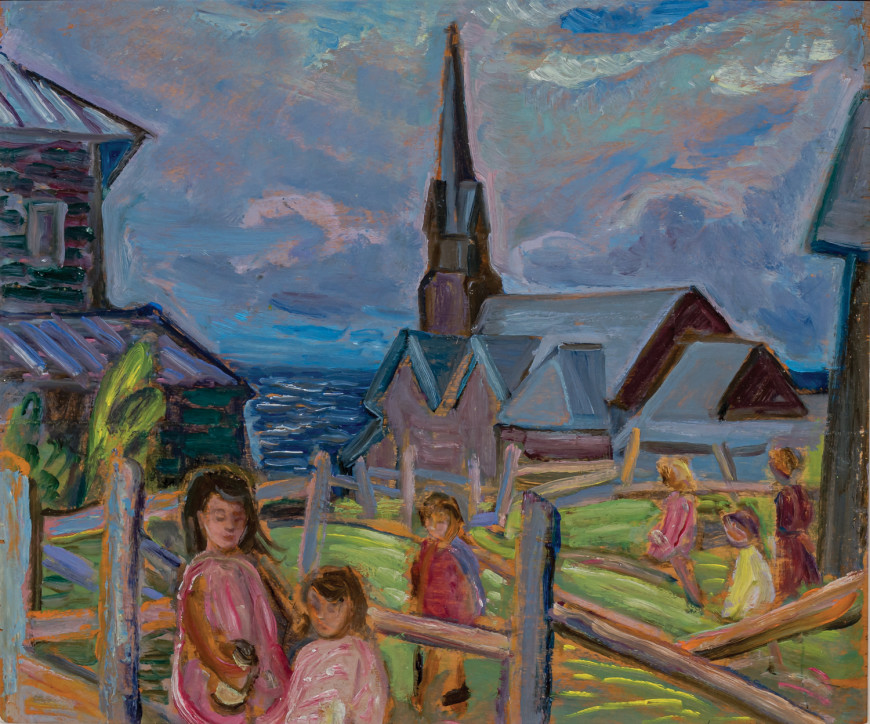-
Œuvres d'art
Anne SavageChildren Playing, Metis, Quebec, 19401896-1971Oil on board12 x 14 in
30.5 x 35.6 cmSoldInscriptions
inscribed and dated ‘Metis / 1940’ (verso, center)Provenance
Roberts Gallery, Toronto.
Galerie Valentin, Montreal.
Waddington & Gorce Inc., Toronto.
Masters Gallery, Calgary.
Galerie Valentin, Montreal.
Private Collection, Toronto.
— Anne Savage was one of the original members of the Beaver Hall Hill Group, the Montreal-based artists who held exhibitions in 1921 and 1922 in a shared studio building at 305 Beaver Hall Hill.
This special oil painting on board, painted in one of the locations synonymous with Anne Savage, is particularly remarkable for its representation of her art and her life. With its depiction of wind and waves to highlight the power of nature, and its bold colours and strong sense of design, it is firmly rooted in the school of Canadian modernism of which Savage was a pioneer. However, it is also personal and intimate, serving to recall Savage's childhood family vacations in Metis, and her lifelong association with children.
Anne Savage's father was a widower with seven children. His second wife, Helen Galt, with whom he had four more children, including Anne, was a niece of Sir Alexander Galt, one of the founders of confederation. Savage was thus accustomed to being around children and also imbued with a strong sense of history. Her mother and aunt were both strong women, and Savage would later recount the importance of such role models.
Savage's appreciation of the Canadian landscape is known to have developed in part after her family moved to a farm in Dorval, then a rural community and today an urban neighbourhood on Montreal's West Island. In 1911, the Savage family also purchased a property at Lake Wonish, in the Laurentians near Morin Heights. In the summers the Savage family would visit Metis, on the south shore of the St. Lawrence river near the Gaspe Peninsula.
Savage excelled at art in high school, and in 1914 she began classes with Maurice Cullen and William Brymner at the Art Association of Montreal (AAM). Cullen, who had exhibited in the French Salons as early as 1894, would be a significant inspiration for the Group of Seven and other Canadian artists searching for a uniquely Canadian interpretation of the landscape. At the AAM Savage also met many of the other artists who would become associated with the Beaver Hall Hill Group. She would herself become a lifelong teacher, encouraging a "childcentred approach", one also promoted by Arthur Lismer.
Savage would return frequently to Metis as an adult, as she did when she painted this work. Her legacy as one of the original artists of the Beaver Hall Hill Group is arguably exceeded by her contribution to the circle of friendship and encouragement that endured for decades afterwards. As Barbara Meadowcroft wrote:
Friendships formed during Brymner's classes were rekindled on Beaver Hall Hill. And years after the studios were abandoned, the women continued to work together. They encouraged each other, shared news of art exhibitions, and offered constructive criticism of each other's work. At a time when women were having difficulty breaking into the predominantly male art world, they formed a valuable network.
Paintings by Anne Savage were included in the British Empire Exhibitions at Wembley, England in 1924 and 1925. She went on to become a founding member of the Canadian Group of Painters in 1933 and remained involved in teaching through the 1950s. Her paintings are in the collections of the National Gallery of Canada, The Montreal Museum of Fine Arts, and the Musée national des beaux-arts du Québec, to name a selection.
_________
“Retrospective Exhibition September 12 -26, 1992: Anne Savage (1896-1971)”. La Galerie Walter Klinkhoff., p. 6.











